Want Growth? Here’s What Consumer Goods Brands Need to Do Right Now

What’s next for your brand? Here are the action items that should top your checklist - and they’re powered by AI and data.
As we head into 2024, there’s cautious optimism about the economy, but uncertainty lingers over how consumers will behave. Although the consumer goods (CG) industry trends toward steady growth these days, it’s harder to capture, and retailers warn about potential deflation in some categories. This year, driving growth will be more critical than ever.
Although 93% of companies are unable to grow margin and drive growth at the same time — even in the best of times — 90% of CG decision-makers expect to do so through mid-2025. But to make that happen, CG brands will need to be ready to adapt to changes faster than ever before.
Your data holds the key to profitable growth
Consumer goods brands can unlock opportunities across the entire route to market.



Based on Salesforce research and consumer goods industry trends, here are the action items we think industry leaders should focus on right now:
Prepare your data for generative AI
Everyone’s talking about artificial intelligence (AI), and CG brands are eager to see how it can transform marketing, commerce, service, and operations. But your AI’s output is only as good as the data on which it’s trained.
Across organizations, data sources are exploding, with brands averaging 976 siloed systems. For example, marketers collect data from an estimated 18 sources — up from 10 in 2021. This includes B2B and B2C data as well as consumer goods industry trends and market data.
Want AI to write marketing copy in your brand voice, create product descriptions that resonate with the product category, and generate website images that meet your consumers’ expectations? Then it’s critical your customer and product data is unified, accurate, bias-free, and secure. This means unifying and integrating data sources across the organization on a single platform, prioritizing data security so your customer data stays within your systems.
Pro tip: Cleaning up your data is important, but you don’t have to wait until everything is perfect to ramp up AI initiatives. Your data cleanup is not one-and-done — it’s an ongoing process. AI is powered by data. Collect and organize your data, identify any gaps, and continue to build and evolve your data strategy to move forward.
Use AI and automation to turbocharge hyper-personalization
When it comes to consumer goods industry trends, personalization continues to be the key to winning consumers’ hearts and wallets: 73% of consumers expect companies to understand their unique needs and expectations. So it’s no surprise that a whopping 89% of CG decision-makers say their company is investing in personalization more than ever before.
In 2024, CG brands need to build personalized sales and marketing experiences using AI and data. Marketers can use AI to create segments with real-time data and automate campaigns to speak to those audiences more effectively. AI also helps with content creation, like generating subject lines, copy, and even images, and can offer guidance on time and frequency of communication so consumers are more likely to respond.
With B2B customers, CG brands can also use those same tactics, as well as predictive analytics, to generate customized demand forecasting, deliver automated quoting and pricing, and power data-driven account management to identify growth opportunities based on individual accounts’ history and performance.
Pro tip: Be sure your AI is keeping your trusted customer data within your own systems. Creating assets with Chat GPT, for example, exposes your confidential data to the public and allows public large language models (LLMs) to be trained on your proprietary information. Look for an AI solution that masks your data, forgets the prompt once it generates its response, and does not store your information outside your own systems.
Lean into data to jumpstart guided selling
Our research shows that 87% of B2B buyers expect sales reps to act as strategic advisors. But how can they do that when sellers are swivel-chairing between spreadsheets, customer emails, and various reporting tools? They’re wasting time on rote tasks rather than strategic thinking, sacrificing efficiency and accuracy in the process.
Once you’ve unified your data and applied AI, key account managers (KAMs) can easily access info like base and incremental volume prediction and guidance on strategies to forecast and build account plans. They can even enable automated deck creation for monthly and quarterly business reporting by simply asking AI. This helps KAMs plan and pivot quickly as well as compare scenarios, so they can create the most effective plans for their accounts.
In 2024, sales teams will literally talk to their data to maximize selling opportunities.
Using AI, forward-thinking sales organizations will ask natural language questions like “What are my top-performing promotions nationally?” or “What new items have been accepted but not shipped yet?” AI will respond with insights about the products KAMs should sell in particular stores and in what quantities.
AI can also help KAMs generate customized sales pitches for their accounts and create personalized sales plans based on their unique performance and goals. AI will handle the time-consuming number-crunching and analysis and can structure key account management conversations across hundreds of customers, all from the same data.
Pro tip: To further improve efficiency and effectiveness, sales teams should build prompt libraries with pre-defined templates, questions, or scenarios that can be used with AI. Pilot the initiative with your top KAMs to see how they use the library. Drawing on a proven collection of prompts means consistency across questions and responses for all accounts. It also saves the sales team time and can take into consideration compliance and regulation issues.
Skill up and scale up your contact centers
Despite a clear need for omnichannel experiences, only 4% of CG executives say their organizations have a fully realized omnichannel sales and service strategy. If you’re not part of that 4%, you could be missing out on a huge opportunity: When customer service gets an upgrade across every channel, service turns into a revenue stream. AI helps make operations more efficient, improve customer experiences, and create new opportunities for upselling or cross-selling.
Start by supporting your agents with chatbots and virtual assistants that can handle routine customer queries and support issues. Then use AI to create call summaries with clear insights, automate action plans with next steps, generate customer emails and service replies, and make order recommendations and summaries. This frees up human agents to focus on more complex issues as well as offer white-glove service. What’s more, AI can analyze data for patterns and predict cross-selling opportunities, so agents can recommend additional products or services to customers, leading to increased revenue.
In the field, AI can predict potential customer service issues and alert field reps so they can address issues before they become problems. This keeps customers happy and relationships strong. And, whether you’re serving customers or consumers, your agents and field reps should have access to all your customer data so they can offer the best service experience.
Pro tip: Connect your service teams with the same data used by your sales team for seamless omnichannel execution, whether in a retail store or a call center. Linking data also helps sales reps stay aware of equipment issues, product shortages, or missed deliveries so they have answers before walking into a sales call.
Use these consumer goods industry trends to achieve profitable growth
CG brands are looking to deliver profitable growth in 2024. To do that, they’ll need to use their data, build brand relevance, and unlock efficiencies. That means it’s time to embrace automation, AI, and your own trusted data to identify and address both sticking points and opportunities. Start by identifying areas for improvement across your organization, then apply the actions above to help move the needle.
Deliver profitable growth
Discover insights and trends from 1500+ consumer goods decision-makers worldwide.




























